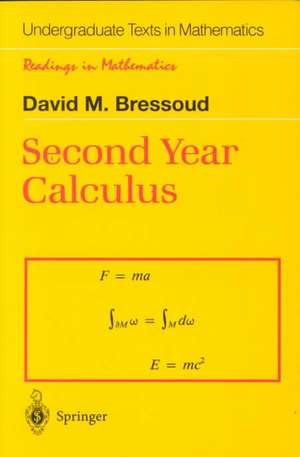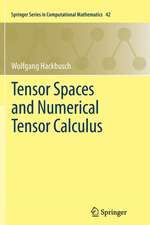Second Year Calculus: From Celestial Mechanics to Special Relativity: Undergraduate Texts in Mathematics
Autor David M. Bressouden Limba Engleză Paperback – 8 aug 1991
Din seria Undergraduate Texts in Mathematics
- 17%
 Preț: 362.13 lei
Preț: 362.13 lei - 17%
 Preț: 365.42 lei
Preț: 365.42 lei - 20%
 Preț: 466.83 lei
Preț: 466.83 lei -
 Preț: 400.42 lei
Preț: 400.42 lei -
 Preț: 298.00 lei
Preț: 298.00 lei -
 Preț: 364.40 lei
Preț: 364.40 lei - 8%
 Preț: 384.89 lei
Preț: 384.89 lei -
 Preț: 257.71 lei
Preț: 257.71 lei - 17%
 Preț: 395.93 lei
Preț: 395.93 lei -
 Preț: 380.26 lei
Preț: 380.26 lei -
 Preț: 339.36 lei
Preț: 339.36 lei -
 Preț: 372.26 lei
Preț: 372.26 lei -
 Preț: 370.77 lei
Preț: 370.77 lei -
 Preț: 440.01 lei
Preț: 440.01 lei -
 Preț: 402.33 lei
Preț: 402.33 lei - 17%
 Preț: 366.38 lei
Preț: 366.38 lei -
 Preț: 433.85 lei
Preț: 433.85 lei -
 Preț: 290.80 lei
Preț: 290.80 lei - 19%
 Preț: 368.78 lei
Preț: 368.78 lei -
 Preț: 400.42 lei
Preț: 400.42 lei - 19%
 Preț: 400.52 lei
Preț: 400.52 lei -
 Preț: 359.48 lei
Preț: 359.48 lei -
 Preț: 415.94 lei
Preț: 415.94 lei - 17%
 Preț: 373.59 lei
Preț: 373.59 lei -
 Preț: 407.62 lei
Preț: 407.62 lei -
 Preț: 407.96 lei
Preț: 407.96 lei -
 Preț: 358.10 lei
Preț: 358.10 lei -
 Preț: 280.65 lei
Preț: 280.65 lei - 17%
 Preț: 368.60 lei
Preț: 368.60 lei - 17%
 Preț: 367.24 lei
Preț: 367.24 lei -
 Preț: 395.09 lei
Preț: 395.09 lei -
 Preț: 424.14 lei
Preț: 424.14 lei -
 Preț: 304.91 lei
Preț: 304.91 lei - 13%
 Preț: 389.61 lei
Preț: 389.61 lei - 17%
 Preț: 362.67 lei
Preț: 362.67 lei - 15%
 Preț: 417.73 lei
Preț: 417.73 lei -
 Preț: 332.02 lei
Preț: 332.02 lei -
 Preț: 329.94 lei
Preț: 329.94 lei - 19%
 Preț: 492.82 lei
Preț: 492.82 lei -
 Preț: 396.24 lei
Preț: 396.24 lei -
 Preț: 390.08 lei
Preț: 390.08 lei - 15%
 Preț: 521.04 lei
Preț: 521.04 lei -
 Preț: 402.00 lei
Preț: 402.00 lei - 15%
 Preț: 531.72 lei
Preț: 531.72 lei
Preț: 447.81 lei
Preț vechi: 526.84 lei
-15% Nou
Puncte Express: 672
Preț estimativ în valută:
85.69€ • 89.71$ • 70.90£
85.69€ • 89.71$ • 70.90£
Carte tipărită la comandă
Livrare economică 07-21 aprilie
Preluare comenzi: 021 569.72.76
Specificații
ISBN-13: 9780387976068
ISBN-10: 038797606X
Pagini: 404
Ilustrații: 404 p.
Dimensiuni: 155 x 235 x 21 mm
Greutate: 0.56 kg
Ediția:1991
Editura: Springer
Colecția Springer
Seriile Undergraduate Texts in Mathematics, Readings in Mathematics
Locul publicării:New York, NY, United States
ISBN-10: 038797606X
Pagini: 404
Ilustrații: 404 p.
Dimensiuni: 155 x 235 x 21 mm
Greutate: 0.56 kg
Ediția:1991
Editura: Springer
Colecția Springer
Seriile Undergraduate Texts in Mathematics, Readings in Mathematics
Locul publicării:New York, NY, United States
Public țintă
Lower undergraduateCuprins
1 F=ma.- 1.1 Prelude to Newton’s Principia.- 1.2 Equal Area in Equal Time.- 1.3 The Law of Gravity.- 1.4 Exercises.- 1.5 Reprise with Calculus.- 1.6 Exercises.- 2 Vector Algebra.- 2.1 Basic Notions.- 2.2 The Dot Product.- 2.3 The Cross Product.- 2.4 Using Vector Algebra.- 2.5 Exercises.- 3 Celestial Mechanics.- 3.1 The Calculus of Curves.- 3.2 Exercises.- 3.3 Orbital Mechanics.- 3.4 Exercises.- 4 Differential Forms.- 4.1 Some History.- 4.2 Differential 1-Forms.- 4.3 Exercises.- 4.4 Constant Differential 2-Forms.- 4.5 Exercises.- 4.6 Constant Differential k-Forms.- 4.7 Prospects.- 4.8 Exercises.- 5 Line Integrals, Multiple Integrals.- 5.1 The Riemann Integral.- 5.2 Line Integrals.- 5.3 Exercises.- 5.4 Multiple Integrals.- 5.5 Using Multiple Integrals.- 5.6 Exercises.- 6 Linear Transformations.- 6.1 Basic Notions.- 6.2 Determinants.- 6.3 History and Comments.- 6.4 Exercises.- 6.5 Invertibility.- 6.6 Exercises.- 7 Differential Calculus.- 7.1 Limits.- 7.2 Exercises.- 7.3 Directional Derivatives.- 7.4 The Derivative.- 7.5 Exercises.- 7.6 The Chain Rule.- 7.7 Using the Gradient.- 7.8 Exercises.- 8 Integration by Pullback.- 8.1 Change of Variables.- 8.2 Interlude with Lagrange.- 8.3 Exercises.- 8.4 The Surface Integral.- 8.5 Heat Flow.- 8.6 Exercises.- 9 Techniques of Differential Calculus.- 9.1 Implicit Differentiation.- 9.2 Invertibility.- 9.3 Exercises.- 9.4 Locating Extrema.- 9.5 Taylor’s Formula in Several Variables.- 9.6 Exercises.- 9.7 Lagrange Multipliers.- 9.8 Exercises.- 10 The Fundamental Theorem of Calculus.- 10.1 Overview.- 10.2 Independence of Path.- 10.3 Exercises.- 10.4 The Divergence Theorems.- 10.5 Exercises.- 10.6 Stokes’ Theorem.- 10.7 Summary for R3.- 10.8 Exercises.- 10.9 Potential Theory.- 11 E = mc2.- 11.1 Prelude to Maxwell’s Dynamical Theory.-11.2 Flow in Space-Time.- 11.3 Electromagnetic Potential.- 11.4 Exercises.- 11.5 Special Relativity.- 11.6 Exercises.- Appendices.- A An Opportunity Missed 361.- B Bibliography 365.- C Clues and Solutions 367.- Index 382.
Recenzii
The subtitle of this book, ``From celestial mechanics to special relativity'' is correctly indicative of its content, and in the preface, the author enthusiastically pleads guilty to blurring the line between mathematics and physics. One of the book's merits is the substantive historical material given. Among other purposes this serves to show the physics setting in which many calculus concepts have their origin. The book eventually gets around to a fairly honest mathematical treatment of the traditional material of advanced calculus via differential forms, but before arriving at this in Chapter 5, mathematics students are likely to have some frustrating experiences. In Chapter 4 one encounters ``we define $\int\sp{bar b}\sb{bar a}f\sb 1(x,y,z)dx+f\sb 2(x,y,z)dy+f\sb 3(x,y,z)dz$ to be the work done by this force field as it moves a particle along the directed line segment from $bar a$ to $bar b$''. Exercise 8 at the end of this section states ``Prove that in an arbitrary force field the amount of work done in moving from $bar a$ to $bar b$ may be dependent on the path''. So, one asks oneself, how is {\it work} defined? Nothing more is to be found than the statement in Chapter 2 that work is force times distance, and the resulting representation as a dot product of vectors. The book has much to recommend it. If the first four chapters are primarily to serve as providing some intuitive foundation, it might be better to more explicitly acknowledge this, and to find a more appropriate formulation for whatever is intended in exercises such as the one cited above. ZENTRALBLATT MATH











